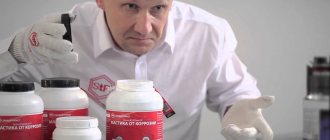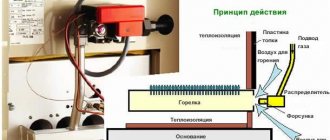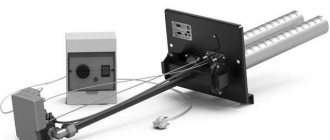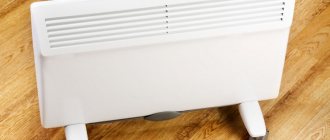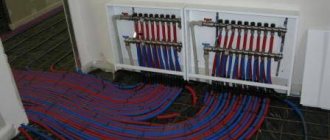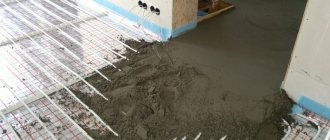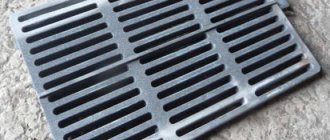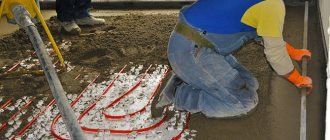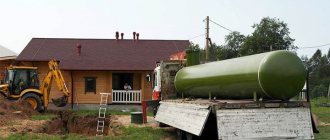Heating an individual house is one of the main conditions for long-term residence of residents in it; the level of comfort for people in the premises, ease of maintenance and financial costs for fuel depend on its normal functioning and structural design. To prevent negative consequences in emergency situations in cold weather associated with power outages and freezing of water in the system, antifreezes act as the heat supply medium, and the consumer should know how to fill a closed-type heating system with antifreeze.
Anti-freeze agents are classified as products that have a limited service life; during operation, pipes, heat exchange devices and fittings gradually accumulate contaminants. Therefore, during operation, it is necessary to repeatedly drain and fill the circuit with an antifreeze composition after flushing or temporary decommissioning of pipelines and branches of heated floors, boilers, and radiators.
Rice. 1 Closed system nodes
How to pump coolant
Pumps for filling the circuit with antifreeze can be different. Any water pump that is used in water supply is suitable for this purpose, since antifreeze can be properly poured into the heating system using any pressure blower of sufficient power. This includes manual and electric pumps, which can pump liquid in different ways. Some of them are immersed in the coolant, while others are not.
Submersible pump
Vibrating submersible pumps operate when completely immersed in antifreeze. Such devices include the well-known “Baby”. It should be said that there is no special pump for filling the heating system with antifreeze. All units have a wide range of applications on the farm. So, for example, “Malysh” can not only pump antifreeze into the circuit, but also lift water from the well.
“Baby” – submersible rotary pump
Advantage of submersible pump:
- inexpensive;
- compact;
- economical;
- portable.
With this pump you can do everything - from watering garden beds to supplying water from a well. It has a metal body, which makes the device reliable and durable. Characteristics:
- capable of pumping 430 liters per minute;
- distance from the power source is up to 40 m;
- two types of fluid intake (upper, lower);
- lifts a column of liquid to a height of 40 m;
- consumes no more than 250 W per hour.
Liquid from ten meters creates a pressure of one atmosphere, it turns out that “Kid” is capable of pumping up to four atmospheres. This power is more than enough for an autonomous heating system. As you know, the pressure in it does not exceed two atmospheres; the norm is considered to be a pressure gauge reading of one and a half atmospheres.
Taking into account the high pumping speed, such a pump will pump up an ordinary system containing up to 100 liters of coolant in a few minutes. The principle of operation is that antifreeze enters directly into the pump through holes in the housing and is supplied to the circuit through a hose.
To roll antifreeze into the heating circuit, you will need a barrel into which it will be poured. Then the pump is placed in the barrel, and the hose is connected to the recharge pipe.
Drainage pump
Drainage submersible pump
Drainage pumps also belong to submersible pumps, but only their main purpose differs from the same “Baby”. This type of blower is designed specifically to pump out water from basements or even from plots of land. A special feature of this unit is its ability to pass large particles, the size of which varies up to 35 mm.
It does not have a filter element that would protect the circuit from contamination, so this must be taken into account before pumping the heating system with antifreeze. In addition, you will need to make sure that the pump does not turn off automatically when there is a minimum amount of coolant left in the tank. The fact is that the submersible drainage pump has a special float switch that responds to changes in the liquid level.
The principle of pumping antifreeze into the heating system with a drain pump is the same as that of other submersible
The only thing you should pay attention to is the dimensions of the device. It may not fit into the neck of a small barrel, so the inlet hole should be enlarged
Surface pump
Surface pumps are not immersed in liquid. They are installed separately, antifreeze is supplied through a hose. These are undoubtedly more powerful units, but they also cost more. Such pumps can pump very high pressure into the circuit, which allows them to be used for pressure testing of heating systems and hydraulic tests. Surface pumps are either mechanical or electric.
Rotary Type Electric Surface Pump
According to the principle of action they can be:
- membrane;
- rotary;
- piston
The first two types are electrical devices, and a piston pump is a manual unit with a liquid reservoir. Antifreeze is poured into the reservoir, which is pumped through low and high pressure cylinders. The device is equipped with a pressure gauge. When pumping antifreeze into the system, a lot of effort will be required. You will need to press very hard on the handle. How to pour antifreeze into the heating system video:
To summarize, we note that you can fill the heating system with antifreeze using any pump that you have on the farm. If there is none at all, then the purchase will not be one-time. Such a unit is always useful in a private home. It can be used to water a garden, pump water from an artificial lake, fuel a heating system, and much more. The principle of filling the heating circuit does not depend on the selected supercharger. The main thing is to monitor the pressure gauge readings and bleed the air.
Filling technology: where to supply coolant
The necessary means are a container and a pump that creates the required pressure of the coolant liquid. Submersible type “Gnome” or “Kid” are quite suitable (popular with gardeners who use them for watering areas located above the levels of reservoirs). There is evidence of successful filling of closed systems using hand pumps - from those used for spraying protective solutions on garden crops, to specialized hand pumps used for pumping motor fuels or liquid chemicals from drums. Any heating circuit can be successfully filled by monitoring the pressure using a pressure gauge.
Filling the system with antifreeze using a submersible vibration pump.
The first step is to select the fluid entry point. If the pressure created by the pump raises the liquid to the top of the system, it should be connected at the lowest point of the boiler room - the coolant make-up pipe, cut into the “return” in front of the boiler. In addition to the make-up inlet, a structurally separate drain outlet is required (two different system components). The first is equipped with a valve (ball valve) and a check valve, the second - only with a valve (ball valve). If the lowest point of the system is the water drain fitting from the boiler, then you can drain/fill the system with water through it. Since a check valve is not installed behind the boiler drain (behind the drain at all), any shutdown of the pump will cause the pumped liquid to leak out - you need to quickly turn off the tap in front of the fitting.
Design of a typical drain/recharge unit.
How to pour antifreeze into an open system
This is exactly the case when you should buy safe propylene glycol. It's all about the open expansion tank communicating with the atmosphere. Since it is located within the house (usually in the attic), small amounts of fumes can enter the living spaces. In general, pouring antifreeze into an open system is not advisable. It is better to convert it into a closed one, from where it will not evaporate.
The diluted concentrate is poured through an expansion tank or make-up valve using a pump. In this case, all Mayevsky air valves installed on radiators must be open. As the tank is filled, the taps are closed, after which the coolant level is brought to approximately 1/3 of the expansion tank.
Advice. Before you pump antifreeze into the heating system of your home with your own hands, you need to make sure that all shut-off and control valves are open.
After starting and warming up the boiler, you need to bleed the air through the batteries again. If the level of heated coolant in the expansion tank has dropped, then add antifreeze to about half.
Antifreeze volume calculation
When purchasing expensive anti-freeze units, in order not to overpay, before filling the heating system, you should know the required volume of coolant. The easiest way to accurately determine it is to pump water into the main line with a pressure of 1 - 1.5 bar, and then drain it and measure the resulting amount. You can add 10% to the mass of the liquid for airing and evaporation of the coolant.
If experimental filling to determine the required volume of coolant is not feasible for some reason, you can use a simple formula for adding the volumes of the main components of the system: radiator heat exchangers, boiler, expansion tank capacity and pipeline:
V (system) = V (boiler) + V (cistern) + V (batteries) + V (pipes)
The working volume of the boiler and expansion tank is determined from the passport data for the equipment provided by the manufacturer. In the same way, the capacity of radiators is determined from the operating instructions by multiplying the indicators of one section by their number. In the absence or loss of passports for the boiler, hydraulic accumulator or radiator heat exchangers, the necessary information is obtained from Internet sources.
The volume of the working fluid in the pipeline is determined by multiplying its cross-sectional area by its length according to the well-known formula:
V (volume) = S (area) x L (length) , where
S (area) = 3.14 (pi) x R2 (radius squared).
Rice. 9 Example of calculated data for finding volume
Advantages and disadvantages of coolant water
Water is the most common coolant option, the popularity of which is explained by the following advantages:
- Cheap - in financial terms, water is accessible to everyone: you can regularly change the coolant and safely release liquid from the system for maintenance work, because refilling will not entail large costs.
- High thermal performance – water has an increased heat capacity at maximum density. Thus, 1 liter of liquid transfers 20 kcal of heat energy through heating devices - water has no equal in this indicator.
- Maximum safety - water does not cause the slightest harm to the environment or humans.
Coolant water also has disadvantages:
- Freezing - at critical negative temperatures without a regular flow of heat, water quickly turns into a crystalline form, which can cause deformation of the heating system.
- Corrosiveness - water is a powerful oxidizing agent, so it is dangerous for equipment made of some ferrous and non-ferrous metals.
- Aggressive composition - untreated water contains a lot of salts, iron, hydrogen sulfide and other compounds that are layered with sediment and clog heating equipment.
Types of thermal media
The cheapest coolant is water. But the use of water is not always justified. Water should be used in heating systems that are not subject to corrosion. The use of water as a heat carrier has certain reservations. Such a coolant must be processed by distillation, this will protect the heating system from the formation of scale in it. The use of water that freezes at zero temperatures can destroy pipes in the event of an emergency shutdown.
Injecting special “anti-freeze” agents as a coolant allows you to ensure high-quality operation of the home heating system. The market for manufacturers of antifreeze for heating offers various types of thermal media, made on different bases and having certain characteristics, on which their final price depends.
Basic requirements for a coolant:
- 1 The degree of viscosity of the coolant with temperature changes;
- 3 The thermal fluid must not be corrosive and be safe for residents in terms of toxicity and ignition;
- 4 Thermal conductivity of the material;
- 5 The price of the thermal fluid must correspond to its payback period.
2 Inertness of antifreeze in relation to other materials;
Antifreeze reaction to overheating
One of the characteristics of all antifreezes is the operating temperature range. This factor is very important - this type of coolant has a very negative attitude towards overheating, as a result of which the material begins to collapse. The boiling point of antifreeze, depending on the type, can vary from 106 to 116 degrees Celsius. This difference largely depends on the amount of water in the coolant.
Exceeding the maximum permissible temperature leads to obvious consequences - first of all, anti-corrosion additives stop working, then boiling glycols begin to decompose into tiny particles, which settle on the internal walls of the heating system in the form of scale, clogging the working channels.
To prevent overheating of the coolant, it is necessary to increase its circulation rate - in this case, the system elements will be protected from high temperatures. Considering that most antifreezes have a relatively low heat capacity, thermal conductivity and high viscosity, for their normal movement it is necessary to select sufficiently powerful circulation pumps and heating devices.
All types of antifreeze are very fluid and easily find various microcracks in which leaks form over time. In addition, heating with antifreeze in a private house does not allow the effect of swelling of the seals to occur, so the smallest gaps for the coolant present under them look like the widest channels for leakage. To get rid of this factor, and at the same time increase the quality of the heating system, you will have to tighten all existing connections well.
The tightness of heating is a very important point, especially when using antifreeze as coolants. It's all about the susceptibility of ethylene glycols to oxidation upon contact with air. The intensity of oxidation increases many times with increasing coolant temperature. Lack of tightness even in a single section of the heating system always leads to a significant reduction in its service life.
The operation of antifreeze has some features related to their physical properties. Unlike water, which begins to crystallize very quickly when the temperature drops, antifreezes change state very smoothly, first becoming more viscous, and only after some time they begin to harden. This rule works both ways - when starting a frozen system filled with antifreeze, you need to increase the boiler temperature gradually so that the coolant has time to react to changing operating conditions.
Antifreezes that are in a frozen state increase in volume so slightly that you don’t have to worry about any danger to the heating system. As the temperature rises, the coolant returns to its original properties. For normal operation, antifreeze poured into the home heating system must be diluted with water in the proportion specified by the manufacturer of the specific type of coolant. In addition, some substances can work independently, without adding water.
New mineral coolants
We decided to highlight the description of these liquids, since they are made based on the natural mineral - bischofite. The substance is a magnesium salt of hydrochloric acid, the full name is magnesium chloride hexahydrate. The manufacturer declares the following characteristics of the finished antifreeze, designed for a minimum temperature of minus 30 degrees:
- the color of the aqueous solution is light yellow, the density is 1117...1250 kg/m³;
- boiling threshold - 116 °C, freezing point - minus 30 °C;
- specific heat capacity - 0.77 kcal/kg •°С (3.23 kJ/kg•°С);
- thanks to the additives, there is no foaming and no aggressive effect on various seals - silicone, paronite, EPDM and BMS rubber;
- the substance is not toxic;
- In terms of viscosity and fluidity, the drug is very close to glycol chemicals.
Reference. The product appeared on the market after 2010. The price of liquid as of 2022 is about 1 USD. e. per liter of finished coolant (-30 ° C).
Compared to traditional glycol analogues, mineral antifreeze benefits due to its high boiling point, cost and health safety. The negative point is the increased density and low heat capacity, 23% worse than that of water.
If you need to order high-quality installation of engineering systems (heating, water supply), please contact DESIGN PRESTIGE by phone +7 , and we will install the system at a professional level in accordance with high quality standards.
The practical use of the coolant has revealed a number of shortcomings, as evidenced by reviews from homeowners:
- The fluidity of the solution is extremely high. There have been cases where antifreeze penetrated through the soldered joint of polypropylene pipes.
- Upon contact with air, the liquid fraction quickly evaporates, leaving a noticeable salt build-up. Similar phenomena are observed in heat exchangers and pipelines where air bubbles have penetrated.
- The substance reacts with bare metal on welds. Stalactites of iron and salt form inside the system, reducing the flow area and clogging the mud traps.
- In case of overheating, antifreeze turns into a slurry of unknown color.
User responses about this type of “anti-freeze” can be read on the well-known construction forum: https://www.stroimdom.com.ua/forum/showthread.php?t=157650
Taking into account the experience of users, we do not dare to recommend mineral antifreezes for use in heating systems of private houses. Perhaps over time, manufacturers will eliminate the above problems and the magnesium chloride solution will be able to compete on equal terms with glycols.
Pros and cons of anti-freeze in the heating system
,
Antifreeze is an indispensable assistant for country cottages and dachas equipped with a heating system. If you do not plan to live there all year round, you will not be able to monitor the condition of the pipes in winter, and the anti-freeze will prevent them from freezing and deteriorating.
Pros of antifreeze:
- you can not drain antifreeze from a non-working system for a long time;
- due to the fact that the pipes and radiators are filled with coolant, air does not enter them;
- due to the presence of additives in antifreeze, the risk of foam formation, corrosion and scale is reduced;
- the antifreeze still freezes, but at temperatures from -30 °C to -65 °C, depending on the concentration of antifreeze;
- You can reduce the viscosity of the antifreeze by diluting it with water. This way you can save the volume of coolant and protect the circulation pumps.
high price; heats up slowly, cools faster than water; it is important to ensure that all joints of the heating system are sealed; some chemicals included in the antifreeze are toxic; cannot be used in all types of heating systems.
Antifreezes for heating and their features
Currently, several types of anti-freeze products are most popular among the average consumer; they are usually sold in plastic canisters with a capacity of 10, 20 or 50 liters. The maximum negative temperature of the solution is indicated on the packaging; it can be used in finished form or before use water is added to it, guided by special tables (the dependence of the crystallization temperature on the volume of antifreeze in the liquid is nonlinear).
Any anti-freeze product contains an active substance with varying percentages (usually about 60 - 65%), distilled or deionized water (30 - 35%), additives, corrosion inhibitors (3 - 4%).
Rice. 6 Cost of 10 liters of ethylene glycol packaging
Ethylene glycol
The retail chain sells red ethylene glycol in canisters of 10 and 20 liters with a freezing point of -30 or -65 °C. The drug has a sweet taste, is poisonous if it enters the human body, and prolonged inhalation of ethylene glycol vapor can also cause short-term health problems.
Poisonous ethylene glycol can be used in closed circuits, where it cannot have a harmful effect on human health upon evaporation. The service life of ethylene glycol is 5 years; before use, the drug is diluted with water to a concentration that requires obtaining the desired freezing point.
Propylene glycol
Anti-freeze made of green polypropylene with the additional commercial name ECO, unlike its ethylene glycol analogue, is not only non-toxic, but also serves as an additive to food products. Propylene glycol is produced in the same containers as ethylene glycol with a freezing point of -20, -30 or -40 ° C, its price is almost 2 times higher than its ethylene glycol analogue.
In terms of its physical parameters (fluidity, thermal expansion, crystallization point), propylene glycol is close to ethylene glycols, with the exception of viscosity, which is 2 times greater. Propylene glycol can be safely used in both open and closed heating circuits.
Rice. 7 Propylene glycols in 10 kg packaging and their price
Glycerol
On sale you can find anti-freeze products based on glycerin with a crystallization temperature at a price slightly higher than or equal to the cost of ethylene glycol, the main properties of the drug:
- Glycerin is harmless and is used in closed and open systems.
- When the temperature limit of 115 °C is exceeded, glycerin decomposes, releasing toxic gas.
- If the content of the water component in the solution decreases, glycerin begins to burn and decompose.
- Has high viscosity.
- It has a less corrosive effect on metal parts than water due to the inclusion of rust inhibitors.
- Subject to foaming, which is removed by introducing a composition of special additives.
- The glycerin solution has increased fluidity and requires the use of dense paronite or Teflon seals.
- Its temperature instability makes it difficult to adjust the boiler.
- Decomposes over time with the formation of a sparingly soluble precipitate and chemically active components that have a negative effect on metals.
- The drug is prohibited for use in the European Union.
Taking into account the above-mentioned features of glycerin, it is not recommended to use it in heating circuits - this will not bring significant financial savings, and eliminating the problems that arise with its use can result in a much larger sum.
Rice. 8 Glycerin anti-freeze
Glycerin
Reviews about coolants of this group are the most contradictory, from the most enthusiastic to the sharply negative.
Positive characteristics of glycerin antifreeze:
- Complete safety for the human body and the natural environment. This is the safest coolant for the heating system of all antifreezes.
- Significant range of operating temperatures. The lower limit of crystallization is 30 degrees, the boiling point is the same as that of water (sometimes higher). Freezing of glycerol is not accompanied by its expansion. An increase in temperature not only liquefies, but also completely restores all the characteristics of the substance.
- Resistant to zinc. In this regard, it is one of a kind among other antifreezes.
- No aggressive effects on the sealing gaskets of the system are observed.
- Absolute fire safety.
- Before pouring glycerin antifreeze, the heating system does not need to be thoroughly rinsed, even if another substance was poured into it before.
- Durability. If you follow the operating rules, coolants of this type can last up to 10 years.
- The level of thermal characteristics here is comparable to propylene glycol. At the same time, glycerin coolants are 20-25% cheaper.
Disadvantages of glycerin:
- Outdated version. Glycerin antifreezes are the most “ancient”: it was in order to improve their performance characteristics that all of the above substances were developed.
- High density and viscosity. Pumps experience significant difficulties pumping glycerin coolant through the heating circuit. As a result, equipment wears out much faster.
- Low heat capacity. In this regard, glycerin is inferior not only to water, but also to propylene glycol.
The heat resistance and environmental safety of the substance deserve special consideration:
- Upon reaching a temperature of +90 degrees, significant foaming of glycerin is observed. To reduce this effect, special additives are usually used.
- The same temperature level triggers the process of chemical decomposition of the liquid. As a result of precipitation, the solid substance gradually layers inside the pipes, and the gas released, acrolein, has a very unpleasant odor, being a weak carcinogen.
- When overheated, water evaporates from glycerin, which makes the liquid very viscous. As a result of this, it loses its characteristics, turning into a jelly-like substance already at a temperature of +15 degrees. It is clear that normal operation of the heating system in such conditions is impossible.
As studies have shown, the main component of counterfeit antifreeze coolants for heating systems is most often glycerin. This is explained by its cheapness, which gave unscrupulous manufacturers the idea to use the material instead of propylene glycol, passing off their products as environmentally friendly high-quality propylene glycol antifreezes
Therefore, when purchasing non-freezing coolants, it is necessary to exercise some caution, requiring quality certificates. It should be noted that in Europe, coolants based on ethylene glycol have long been discontinued, but local companies are in no hurry to return to glycerin.
Finally, about coolants for electrode boilers
Electric water heaters of this type operate on the principle of a “soldier’s boiler” consisting of two blades connected to a 220 volt network. Water simultaneously serves as a coolant and electrolyte; heating occurs due to its conductivity, which depends on the content of magnesium and calcium salts.
This is why electrode boilers do not work with distillate and significantly lose power with under-salted water. According to the passport of the Galan heater, the resistance of the working fluid should be no more than 3200 Ohms per 1 cm.
If you pour regular ethylene glycol into an electrolysis heat generator, the substance will enter into a chemical reaction, foam and lose additives against corrosion and scale formation. The problem can be solved in 2 ways:
- A special antifreeze designed for electrode-type units is purchased. Special additives that resist foaming are dissolved in the working environment.
- A saline solution of the required concentration is prepared, as shown in the video below. Such water will begin to crystallize at a lower temperature, although it cannot be compared with antifreeze in terms of frost resistance.
You should pay attention to the preparation of tap water - pass it through a filter and let it sit for 1-3 days. A good solution is to buy a corrosion inhibitor separately and add it to the coolant for the heating system in advance.
What you need to know to fill antifreeze correctly
Let's start with the fact that it is impossible to mix coolants with different properties, since such a mixture can result in an insoluble precipitate. This will cause the radiator passages and other sensitive parts of the system to become coked over time. To avoid such situations, you only need to fill the car with antifreeze approved for use by the manufacturer of the particular car, and add a similar composition that complements the existing liquid.
The behavior of the cooling composition when water is added to it is an open question. To a certain extent, a diluted mixture can show excellent qualities, provided that distilled water is used. Regular tap water will not work here.
It is worth recalling that the color of the coolant does not depend on its composition. For example, blue and red refrigerant may be absolutely compatible, while two different green liquids will ultimately have different bases and additive compositions.
Many car owners make the mistake of not knowing where to pour antifreeze. And out of ignorance, they always use the radiator socket for this. This hole is indeed present in this device, but only in its collapsible models. Liquid should not be poured or topped up directly into a radiator system with a solid body. Antifreeze enters the radiator and other components of the cooling system through the expansion tank.
If the old fluid is completely replaced with a new one or its brand is changed, the existing refrigerant is drained from the collapsible radiator through an individual hole. The remaining liquid flows out through an additional plug, sometimes covered with a protective panel on the bottom.
A universal instruction will not always help here, since some car models are equipped with non-standard cooling systems with individual drain and fill circuits. This significantly differs the products of English automakers. The standard procedure for filling coolant is simple and consists of several steps that can be performed independently without the help of specialists.
Filling the system from below
So, let's get back to pumping fluid into the system. We use a container of suitable volume (a 200-liter plastic barrel works well). We lower a pump into it, creating the pressure required for pumping liquid no higher than 1.5 atm (typical value in the range of 1-1.2 atm). Such pressure requires the pump to create a pressure of 15 m (for the submersible “Malysh” it reaches 40 m).
Having filled the barrel with water, we start the pump, monitoring the liquid level, which should be located above its inlet pipe to prevent “airing”. The level drops - add water. Antifreeze should be pumped from a smaller container (bucket) so as not to immerse the submersible pump housing in the liquid (and then wash it) - just immerse the inlet pipe. You will have to add antifreeze frequently, turning off the pump periodically.
Filling the system is carried out with Mayevsky taps open on installed heating radiators with substitute containers for collecting water. When liquid comes out of all air vents, close the taps and continue the injection process.
We control the pressure using a pressure gauge (a boiler gauge will do). When its value exceeds the hydrostatic pressure, equal to the pressure in the liquid column height from the bottom to the top point of the system (a height of 5 m gives a static pressure of 0.5 atm), we continue to fill the system, monitoring with a pressure gauge the moment the pressure reaches the required value.
Pumping antifreeze with the “Malysh” pump.
Having filled the system, turn off the pump, open the air valves (the pressure will inevitably drop), and then pump up the water. We repeat the process several times, displacing air bubbles.
We complete the filling by inspecting the system for leaks. After the pump is turned off, the liquid in the hose connected to the outlet pipe is under pressure. If antifreeze was pumped in, first disconnect the hose from the pump inlet pipe and drain the liquid into a container, being careful not to drench the mechanism body.
How to fill a heating circuit with water
Water is still a popular heating medium, mainly because it is cheap. When filling heating systems of older design, with medium-section iron pipes and large cast-iron radiators, the use of water will provide significant savings due to the large total volume of the system. Water also has almost ideal viscosity and heat capacity compared to antifreeze. The viscosity of water is also noticeably lower, reducing the likelihood of it leaking through seals.
This is where the advantages of water end. Even prepared tap water contains a large amount of dissolved mineral additives. There can be tens of times more of them in water from a well or borehole. During operation of the heating system at high temperatures, these substances intensively deposit on the walls of pipes and heat exchangers. At the same time, the effective cross-section of the pipes narrows, the efficiency of heat transfer decreases, and parts of the pump and expansion tank are damaged.
Oxygen contained in water leads to corrosion of metal parts of the system.
If a decision is made to fill the heating circuit with water, it should be chemically cleaned of mineral components or at least boiled and the sediment allowed to settle.
And the biggest danger of water as a coolant is that when cooled below 0°C, it freezes, turning into ice and increasing its volume. This leads to destruction of pipes and heat exchangers, damage to pumps.
It is not enough to know how to add water to the heating system; you also need to correctly determine its volume.
Volume calculation
Before filling the heating circuit, it is necessary to calculate its internal volume.
To do this, sum up the volumes:
- boiler;
- expansion tank;
- pipelines;
- radiators.
To calculate the volume of the heating circuit, the volumes of the boiler, expansion tank, pipelines, and radiators are summed up.
The internal volumes of the boiler, expansion tank and radiators are indicated in their accompanying documentation. They are also listed on the manufacturers' websites.
The volume of the pipe in cubic meters is calculated using the formula
where D is the pipe diameter, m
l- pipe length, m
A correction factor is added to the calculated volume, i.e. multiplied by 1.15.
The volume of water can be determined not only by calculation, but by experiment. To do this, fill the system completely with water and pour it into a measuring container. An experienced one is more accurate.
Rules for heating make-up
During operation of the heating circuit, it is periodically necessary to add water or top up. In open-type systems, this can be done directly into the expansion tank; it is also used to control the water level in the system. If the fluid has not reached operating temperature, do not fill the reservoir completely. When heated, the water will expand and flow over the edge.
Modern double-circuit boilers have a special make-up valve. Filling the system is carried out as follows:
- connect the water hose to the make-up valve;
- open the valve at the lowest point of the circuit next to the boiler;
- open the air valve at the top point of the pipeline;
- When water appears from the air valve, close the make-up valve and the air valve.
- If, when starting the heating, you hear gurgling and the sound of flowing water in the pump, you should repeat bleeding the air through the air valve.
- When filling the system, it is recommended to open the valve no more than ¼ of the cross-section.
If cold water with a temperature of 3-8 degrees was added to the system, before turning on the boiler at full power, it is necessary to allow the liquid in the circuit to move evenly to avoid hydraulic temperature shocks.
Date: September 25, 2022
Conclusions and useful video on the topic
The video will clearly present the process of filling the heating circuit and setting the expansion tank:
Common to all coolants is gradualness when starting the system. The temperature must be increased slowly, step by step, not only because of the coolant, but also because of the additives, which also change their properties with temperature.
The process of filling systems with both water and antifreeze is similar, but the requirements for the quality of work and safety when filling with antifreeze are increasing. Antifreezes that have expired require disposable containers and removal for disposal.
If you have questions about the topic of the article or already have experience in filling heating systems with coolant, please share it with our readers. Leave your comments at the bottom of the article.
Starting the heating of an apartment building
In a multi-storey building with bottom filling, the heating system is started as follows:
- When the supply is closed and the return is closed, the discharge of the supply pipeline opens;
- The return valve opens very smoothly. A sudden opening of the valve will most likely lead to water hammer, which can seriously damage the radiators, even to the point of rupture;
- After some time, water without air will come out of the discharge. When this happens, the discharge closes and the supply pipeline valve opens;
- All that remains is to bleed the air from all parts of the system where this is possible.
Replacing water with antifreeze
If the system has already used water, and you want to switch to antifreeze, then two circumstances should be taken into account.
Secondly
, it is never possible to completely remove water from the heating system. Some of the water remains. If you simply pour prepared diluted antifreeze, its concentration will be insufficient for reliable protection against freezing. Thus, a concentrate must be used. I usually mix concentrate with diluted antifreeze in a 1:1 ratio. After filling the system, you need to start the circulation pump (for a system with forced circulation) or turn on the boiler (for a system with natural circulation) so that the coolant is thoroughly mixed. Then you need to pour a little coolant and measure its density. There is a device for measuring density that is sold in most car dealerships. This device is used to prepare a car for winter (checking the properties of antifreeze in the engine cooling system), but it is also perfect for our purposes. If the device shows a freezing temperature lower than necessary, for example -50 degrees, it’s okay, but if the temperature is higher than we need, then we will have to drain part of the coolant and replace it with concentrate. The drained coolant must be disposed of carefully; it is poisonous and should not be poured into septic tanks or ditches.
I would also like to draw your attention to the fact that different antifreezes may be incompatible with each other. There is an opinion that red composition should not be mixed with a composition of another color.
This is true, but in fact there are other undesirable combinations. Supplements from different brands may react with each other or simply reduce each other's effectiveness. Unfortunately, manufacturers do not indicate what other antifreezes their product can be mixed with. My advice is to pick one brand and stick with it. If you still need to mix, then mix liquids of the same color and before pouring, pour out a little coolant from the heating system, mix it in a jar with a new composition and see if a sediment forms, if the liquid becomes cloudy, or loses its homogeneity.
Unfortunately, errors are periodically found in articles; they are corrected, articles are supplemented, developed, and new ones are prepared. Subscribe to the news to stay informed.
It is convenient to fill the system through the water drain tap - it is located at the lowest point of the system. With this method, airing is practically eliminated, since the coolant enters from below, gradually squeezing out all the air into the expander. Read the answer.
Examples of adhesives. Poxypol, liquid nails, universal superglue. Armir. Typical gluing errors. The right technology. Additional techniques - armir.
Techniques for fixing a threaded connection. Techniques for fixing (locking) a threaded connection. Protection against vibration and self-promotion.
Apricot, apricot tree. Growing, planting, propagation, watering. How to plant and grow apricots. We propagate, graft, water apricot de.
Thrips. Colourless/yellowish spots, rough stripes, leaves. How to identify a thrips infestation. Light spots and roughness are signs of disease.
